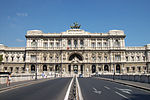Sacro Cuore del Suffragio
20th-century Roman Catholic church buildings in ItalyChurches of Rome (rione Prati)Gothic Revival church buildings in ItalyRoman Catholic churches in Rome

Sacro Cuore di Gesù in Prati (Italian for "Sacred Heart of Jesus in Prati"), also known as Sacro Cuore del Suffragio (Italian for "Sacred Heart of the Suffrage"), is a catholic church in the centre of Rome (Italy), rising in the rione Prati, hosting the parish with the same name, entrusted to the Missionaries of the Sacred Heart.The church, designed by engineer Giuseppe Gualandi, is sometimes referred as the little Milan Cathedral, due to its rich neogothic style.
Excerpt from the Wikipedia article Sacro Cuore del Suffragio (License: CC BY-SA 3.0, Authors, Images).Sacro Cuore del Suffragio
Lungotevere Prati, Rome Municipio Roma I
Geographical coordinates (GPS) Address External links Nearby Places Show on map
Geographical coordinates (GPS)
| Latitude | Longitude |
|---|---|
| N 41.904188888889 ° | E 12.472325 ° |
Address
Sacro Cuore del Suffragio (Sacro Cuore di Gesù in Prati)
Lungotevere Prati 12
00186 Rome, Municipio Roma I
Lazio, Italy
Open on Google Maps











